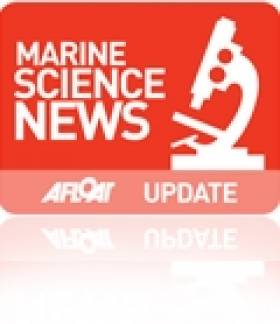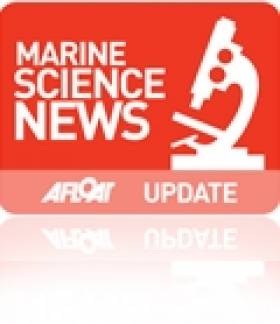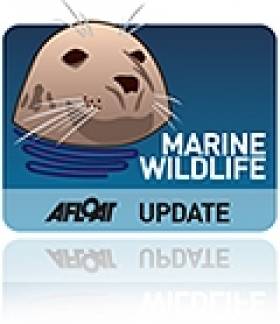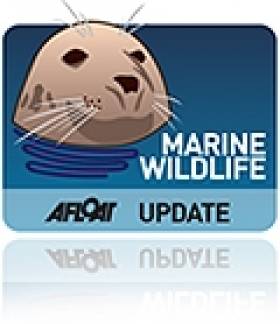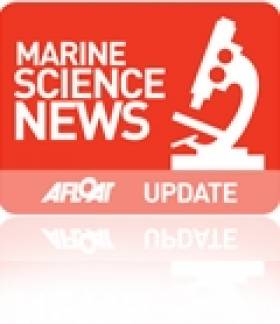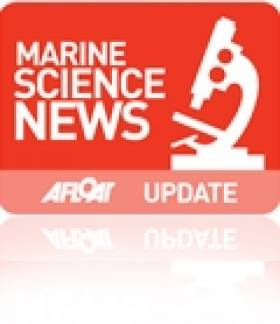Displaying items by tag: marine science
#MarineWildlife - A humpback whale new to Irish waters has been confirmed by the Irish Whale and Dolphin Group (IWDG).
Photos of the humpback's fluke and dorsal fin captured by Nick Massett off Clogher and Sybil Heads in West Kerry at the weekend were examined by the IWDG's catalogue experts who have determined that the whale is a new arrival - and one with a fluke colouring that's rarely seen in Irish waters.
Details have since been sent to Allied Whale in the US state of Maine - which curates the North Atlantic humpback whale catalogue - to see if a match can be made among its database of more than 7,000 fluke images.
Meanwhile, Wildlife Extra reports that sailors in the Irish Sea are urged to keep a lookout for a large group of minke whales.
The group includes three juveniles and a calf previously spotted some 19 miles east of Ireland's Eye near Howth.
"Although sightings of Minke whale are to be expected in these waters, such a large group is a rare occurrence," said Danielle Gibas, sightings officer with the UK's Sea Watch Foundation, which is organising Britain's annual National Whale and Dolphin Watch this week till 3 August.
And in other cetacean news, scientists claim that dolphins call each other by name, calling back to the sound of their signature whistle but ignoring whistles that aren't theirs.
Herald.ie reports on the findings by marine scientists at the University of St Andrews, who studied a bottlenose dolphin group off the east coast of Scotland.
Using underwater speakers, they played synthesised versions of dolphin whistles they'd identified with particular dolphins to determine their reactions.
They were surprised to find that individuals called back after hearing their own 'name' but ignored others, whether they were for dolphins in the same group or strangers.
Ireland to Surf New Wave of Marine Technology
#marinescience – Ever since the foundation of the state, far-sighted supporters of Ireland's marine potential in its broadest sense bewailed the lack of any co-ordinated approach to marine research and development.
In recent years, the situation has been improving with new facilities and projects coming on stream.
This week in the Irish Times, Science Editor Dick Ahlstrom highlighted the beginning of construction work on a new research centre in Cork which will be a significant step in the right direction. (see page 12, Irish Times Thursday July 18th).
#MarineScience - Suitable candidates in the marine science field are invited to apply for the accredited continuous professional development module (CPD) titled Applied Marine Biological Sampling and Data Collection.
The module will take place from 30 September to 25 October 2013 and is offered by Galway-Mayo Institute of Technology (GMIT) and the Strategic Marine Alliance for Research and Training (SMART).
Applied Marine Biological Sampling and Data Collection aims to provide attendees with the detailed practical knowledge and skills necessary to design and implement biological sampling and data collection campaigns on marine commercial platforms.
The module is aimed at postgraduate students of marine science and marine industry personnel.
Four days of ship-time sampling and data collection onboard the RV Celtic Voyager and the IWDG's Celtic Mist off Cork and in the Shannon Estuary respectively are supported by three days of intensive laboratory practicals and lectures in GMIT.
- onboard, at practicals and lectures is required from 7-13 October with all other elements accomplished through student-centred distance learning.
Themes addressed include quantitative sampling of fisheries and benthos; surveying and monitoring methodologies for cetaceans and seabirds; tissue sampling and preservation; and oceanographic data collection and sampling.
Completion of the module results in an award of 5 credits at NFQ level 9 under the European Credit Transfer System (ECTS).
The Strategic Marine Alliance for Research and Training (SMART) is a marine science partnership programme designed to further develop capacity in carrying out offshore operations on board research vessels for third level students of marine-related science and technologies.
This strategic collaborative inter-institutional programme is led and funded by Irish Higher Education Institutions (HEIs) and the Marine Institute, and is also supported by the Higher Education Authority (HEA).
The online application forms is available HERE or my e-mailing [email protected]. Further details on the course and its instructors is included in a PDF available to read or download HERE.
#UCC – An Taoiseach Enda Kenny T.D. turned the sod at the site of the new Beaufort Building in Ringaskiddy, in Cork Harbour today (Thursday, 11 July).
Led by University College Cork, which is acknowledged as Ireland's leading maritime science and engineering Institute, the Beaufort building will be a flagship development in the Irish Maritime and Energy Resource Cluster (IMERC). Work will begin immediately on this unique building, which includes the National Ocean Test facility. Over €15 million has been invested in this world-class development.
An Taoiseach welcomed the investment stating that, "I am delighted to be here to turn the sod for the UCC Beaufort Building which will employ 135 people when complete and provide 200 jobs in the construction stage. Ireland needs to be able to compete globally where new research in fields like sustainable energy and maritime science are concerned. The Government's Action Plan for Jobs 2013 recognises this and the UCC Beaufort building will play an important role in the marine energy sector and help to drive Ireland's economic recovery".
"The President of UCC, Dr. Michael Murphy commended the work of the Beaufort Research team led by Beaufort Director and Professor of Energy Engineering at UCC, Prof. Tony Lewis.
"The positioning of Beaufort Research as an international leader in the area of maritime and energy research is evidenced by the success of Beaufort in securing funding in excess of €50 million[1] <#_ftn1> from European programmes and Science Foundation Ireland (SFI) in recent years.
We welcome the development of the Beaufort Building, which brings together the Hydraulics and Maritime Research Centre (HMRC), Coastal Marine Research Centre (CMRC) and the Sustainable Energy Research Group (SERG) to form a cornerstone of the maritime cluster based here in Ringaskiddy. This centre will continue to drive academia and industry to the forefront of global developments in marine renewable energy research."
The Director of Beaufort Research, Prof Tony Lewis, welcomed "this historic day" as the culmination of his career in maritime engineering and marine renewable energy. The realisation of this UCC facility and its location within the IMERC Campus will place Beaufort at the epicentre of research and innovation in the maritime and energy field in the future.
The construction of the new building will commence immediately, creating 200 jobs during development. When completed in 2014, Beaufort Research will employ 135 full time researchers. The Irish Maritime Development Office (IMDO) estimates that direct employment in this high value sector could double over the next five years, leading to further investment and job creation opportunities.
Named after the Irish Hydrographer, Rear Admiral Sir Francis Beaufort, who was responsible for the introduction of the globally adopted Beaufort Scale, Beaufort Research will provide an accessible entry point for national and international industry and research groups focused on sustainable resource development and will ensure Ireland's position as a global leader in maritime and energy markets.
The facilities at the 4,700 sq. metre building will include the National Ocean Test Facility with a teaching flume and a large test flume (35m x 12m x 3m deep) and 12 electric paddles (ocean wave generators, Edinburgh design), multiple beach scenarios, 1m @ 2.7 second waves and a movable floor among other features required for maritime and wave energy research. The infrastructure will also house the ocean wave basin (25m x 18m x 2m.deep) with 40 wave paddles to produce real three dimensional seas at model scale. A coastal flume (27m x 3m x 1m deep) which includes a flow facility can be used to test tidal turbines. There will be mechanical and electrical workshops, a Power Take-Off lab and Energy Storage and Smart-grid labs as well as industry suites and an incubation space of 200 sq. metres initially.
#marinescience – The Marine Institute and Galway Atlantaquaria recently (1st – 5th July) held a seven day teachers training course at Grattan beach and at the aquarium, where over twenty five primary school teachers were introduced to Ireland's marine resource, oceans and the seashore.
School teachers developed new skills and techniques that they can use in and out of the classroom. Ms Bernie Murphy of Scoil Chroí íosa in Galway said, "the time spent on the seashore and experiments in class provided us with a wonderful opportunity to re-engage with our local seashore and become more aware of how useful the beach is as a teaching resource."
Ms Anne Gilmore further added, "we now feel able to identify and tell the wonderful stories about the many species and their habitats along the seashore including cockles, mussels and even the common barnacle - which has a very interesting social life. Learning about the oceans and Ireland's marine resource provided us all with the inspiration to teach students about the marine in fun ways using subjects such as english, art, mathematics, geography, history and science".
The Marine Institute and Galway Atlantaquaria welcomed the opportunity to run the summer course "Linking Science, Numeracy and Literacy by exploring the Seashore and River", which was offered through the Galway Education Centre and approved by the Board of Education.
"Developing workshops for teachers and providing materials and resources for primary schools is an invaluable way to promote Ireland's marine resource and to inspire students with their career choices in the future. As part of the national plan to 'Harness our Ocean Wealth', it is therefore vitally important that students and our local communities are aware of the significant ties we have with the ocean," explained Cushla Dromgool-Regan from the Marine Institute.
"The course uses materials available from the Explorers Education website www.explorers.ie, where teachers are encouraged to take advantage of the vast resources made available by the unique marine environment and help promote marine knowledge throughout Ireland".
The Explorers Education programme is sponsored by the Marine Institute and run by Galway Atlantaquaria. It is used by over 50 schools and reaches 5000 primary school students across Ireland, from Galway, Mayo, Clare, Dublin and Cork.
Rare Ocean Wildlife a Treat for Atlantic Explorers
#MarineWildlife - An Irish marine research vessel has returned from an Atlantic Ocean voyage with tales of exotic new wildlife in the depths southwest of Ireland.
As The Irish Times reports, remarkable finds such as two-century-old clams and oysters, an endangered sailfin roughshark, a massive sponge and a giant hydroid - a rare relation to jellyfish and coral - were among the marine wildlife recorded by researchers on the RV Celtic Explorer in the Whittard Canyon on the Irish Atlantic margin.
Dr Louise Allcock of NUI Galway, who led the Marine Institute team on the ocean survey, said it was "part of an ongoing effort to understand Ireland's deep-sea biodiversity".
In a similar process to that used by the group who made new marine discoveries at Rockall recently, the Marine Institute team used a submersible remotely operated vehicle (ROV) to collect images and samples from the ocean chasm that's twice as deep as the Grand Canyon.
Some of those samples may aid in antibacterial and pharmaceutical research, the team explained.
The Irish Times has much more on the story HERE.
In other marine wildlife news, the Belfast Telegraph fears that "chilly seas" could be keeping basking sharks at bay from Northern Ireland's waters, as the first sighting of the year was recorded last month.
Reports from various sources indicate that water temperatures are 2 to 3 degrees lower than normal for this time of year, inhibiting the blooming of plankton that are the main source of food for the second-largest fish in the sea.
And the numbers say it all, with the Irish Whale and Dolphin Group (IWDG) confirming only 19 sightings of basking sharks around the island of Ireland as of the end of May this year, compared to 84 in the same period in 2012 - although more were spotted earlier this month off Malin Head, as the video below shows:
Rockall Fishing Ban Recommended After New Marine Discoveries
#MarineWildlife - The Guardian reports that fishing is expected to be banned near Rockall after the recent discovery of a rare ocean floor gas vent and new species of shellfish.
The 'cold seep' methane vent found by Scotland-based marine scientists last year is only the third of its kind to be found in this region of the Atlantic Ocean - and apparently has a 'chemosynthetic' relationship with two species of deep-water clam, and the polychaete worms they contain, that are new to science.
Also found was a frilled shark, described as a 'living fossil' for existing as a species for at least 90 million years. Such sharks are seldom seen north of the tropics.
In the wake of these findings, the International Convention on the Exploration of the Seas has recommended a ban on fishing activity at the site and its surrounds.
Rockall - which adventurer Nick Hancock is attempting to occupy for a world record attempt - is a tiny rocky islet north-east of Donegal, almost halfway between Ireland and Iceland in the North Atlantic. It has long been the subject of territorial dispute, with Ireland, the UK, Iceland and Denmark all staking a claim.
The Guardian has much more on the story HERE.
Calls Now Open For Marine Reaearch Funding Under EUROFLEETS2
#MarineScience - Applications are now being invited under EUROFLEETS2, an EU-funded project providing scientists with 200 fully funded days of ship-time and 104 fully funded days of marine equipment to carry out ship-based research activities within any field of marine sciences.
EUROFLEETS2 - which had its kick-off meeting gathering more than 60 marine scientists and fleet operators in April this year - aims to bring together the European research fleets to enhance their co-ordination and promote the cost effective use of their facilities.
The Marine Institute’s research vessels, the RV Celtic Explorer and the RV Celtic Voyager, are both available to researchers through the EUROFLEETS ship-time call. Irish researchers can apply for ship-time on these and other European vessels participating in EUROFLEETS2.
EUROFLEETS2 invites applications for the following marine research funding opportunities:
Super-Integration: This call seeks to fund a truly cross-cutting proposal, multidisciplinary, multiyear and/or multiplatform, which needs to mobilise a combination of EUROFLEETS Research Vessels (RVs) together with other appropriate scientific tools like nationals RVs, research planes or onshore infrastructures with their own EC or national funding. All EUROFLEETS RVs and equipment are available for this call. More information at www.eurofleets.eu/np4/59
Embarked Equipment: This call offers fully funded marine equipment time within participating scientific marine equipment (two 3D HD TV cameras, two ROVs and the sea floor drill rig MARUM-Mebo) to be deployed from RVs or from underwater vehicles funded by other sources than EUROFLEETS2. More information at www.eurofleets.eu/np4/60
The application deadline for both funding opportunities is 16 September 2013.
EUROFLEETS2 is a Research Infrastructures project under the seventh Framework Programme of the European Commission. For more information and eligibility criteria visit www.eurofleets.eu.
#MarineScience - On 20 June last, the European Marine Board presented its blueprint for the next phase of seas and oceans research in Europe to EU Commissioner for Research, Innovation and Science Máire Geoghegan-Quinn and Maria da Graça Carvalho, MEP and European Parliament Rapporteur for the Horizon 2020 Programme, at a special event in the Royal Flemish Academy of Belgium for Science and the Arts in Brussels.
Navigating the Future-IV is an opinion paper representing the views of the European marine science community of the major challenges and opportunities for marine science in Europe to support so-called 'blue growth', prepared by the European Marine Board, a network of 36 European marine research centres from 20 countries.
The current report is structured to inform the research challenges identified by the EU Horizon 2020 Programme in terms of basic research such as understanding ecosystem functioning, as well as the major societal challenges facing Europe over the next decade including health, food security, energy, climate change and raw materials.
Presenting the paper, European Marine Board chair Dr Kostas Nittis recalled the Ostend Declaration of 2010, which called for marine sciences to be recognised as one of great challenges of the 21st century.
He noted that the recent EU Blue Growth Strategy represented the marine component of the Europe 2020 Strategy for smart, sustainable and inclusive growth and he acknowledged the support given to marine science, technology and innovation in the EU’s seventh Framework Programme (2007-2013) including the Ocean of Tomorrow initiative.
Welcoming the report, Commissioner Geoghegan-Quinn acknowledged its relevance and timeliness as the commission and member states were now about to embark on defining the specific topics that would be open to competitive co-funded research under the €80 billion Horizon 2020 Programme spanning the period 2014-2020.
She also welcomed the inclusion of chapters on the need for a European Ocean Observing System and for improvements in ocean literacy amongst European citizens, noting that these two topics were also addressed at the recent Irish EU-Presidency Meeting held in Galway from 23-24 May.
This meeting resulted in the signing of the Galway Statement on Atlantic Research Co-operation by Canada, the USA and the European Union, which represents the first step in internationalising the recently adopted Atlantic Strategy Action Plan.
Carvalho, meanwhile, highlighted the vital role that the marine sector plays in the blue economy which she said is “central to Europe's prosperity and well‐being".
She noted the progress the European Union had made in recent years in recognising that the union had a very important marine dimension, now formally recognised in the Integrated Maritime Policy for the European Union (2007) and its various sea-basin strategies.
She also reported that the European Parliament was aware of the importance of the EU’s maritime interests and had recommended that marine science and blue growth be recognised as one of a number of priority cross-cutting themes to be addressed by the Horizon 2020 Programme.
Geoffrey O’Sullivan, representing the Marine Institute and a member of the European Marine Board, noted that the priories identified in Navigating the Future-IV complemented those in the Irish Marine Plan, Harnessing Our Ocean Wealth, launched by the Government in July 2012.
And according to Ciara Delaney, Irish maritime attaché in Brussels, Navigating the Future-IV reinforces the research priorities included in the recent European Union Atlantic Action Plan (2014-2020) agreed by France, Ireland, Portugal, Spain and the UK, which was launched in Galway on 24 May by EU Commissioner for Maritime Affairs and Fisheries Maria Damanaki.
The Brussels event also launched the EurOCEAN 2014 conference as an Italian-EU Presidency event with a focus on marine science grand challenges.
EurOCEAN 2014 will be held in Rome on 7‐9 October 2014. Announcing the conference, Prof Enrico Brugnoli of the National Research Council in Italy (CNR) said that it “is one of the most important events in marine and maritime research for both scientists and policy makers”.
The conference will be the eighth in a very successful series of European marine science conferences, initiated in Brussels in 1994, and including the EurOCEAN 2004 conference held in Galway.
Marine Institute To Be Centre of Global Marine Research
#MarineScience - Galway Bay FM reports that the Marine Institute in Galway is to become one of the world's leading marine research centres.
The news comes in the wake of a groundbreaking deal signed in Galway on Friday afternoon (24 May) between the EU, the US and Canada to join forces on Atlantic Ocean research, as previously reported on Afloat.ie.
All partners have agreed to commit to funding to study the interplay of the Atlantic with the Arctic Ocean, and discover ways that research on the oceans and marine wildlife can contribute to scientific advances in other areas.
Meanwhile, a monitoring system for waste waters is among the projects that will benefit from a near €1 million in funding from the Science Foundation.
Research Minister Seán Sherlock announced the funding for projects at NUI Galway that is hoped to deliver "commercialisation of research in a range of areas".




























